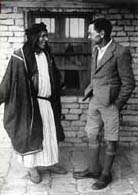Treasures From The Royal Tombs Of Ur
Ur of the Chaldees
Richard L. Zettler
 Perhaps no excavation in the more than 150 years of archaeological work in Mesopotamia has excited as much public attention as C. Leonard Woolley's work at ancient Ur in the1920s and early 1930s... Ur was fabled as the city of the Sumerian moon god Nanna and the traditional home of the biblical patriarch Abraham (Gen. 12:4-5). In the thirteen years of excavations, newspapers around the world printed countless articles. The Illustrated London News, England's "window on the world," reported the results of Woolley's discoveries at Ur in some thirty features, at least two with color illustrations.
Perhaps no excavation in the more than 150 years of archaeological work in Mesopotamia has excited as much public attention as C. Leonard Woolley's work at ancient Ur in the1920s and early 1930s... Ur was fabled as the city of the Sumerian moon god Nanna and the traditional home of the biblical patriarch Abraham (Gen. 12:4-5). In the thirteen years of excavations, newspapers around the world printed countless articles. The Illustrated London News, England's "window on the world," reported the results of Woolley's discoveries at Ur in some thirty features, at least two with color illustrations.
Of all Woolley's discoveries, the mid-third-millennium BC tombs of the Royal Cemetery of Ur, with their rich inventories of gold and evidence of human sacrifice, received more intense coverage than any other... Woolley's excavations competed only with Howard Carter's discovery of the intact tomb of the boy pharaoh Tutankhamen for public attention. As a result of the extensive publicity, Iraqis and tourists from all parts of the globe, including European royalty and even the author Agatha Christie, flocked to the inaccessible site in the Iraqi desert. Christie later married Woolley's young assistant, M. E. L. Mallowan, and set her 1936 mystery Murder in Mesopotamia amid an excavation in Iraq. She attributed Ur's prominence in the popular media not only to the intrinsic interest of Woolley's discoveries but also to Woolley himself. As she wrote in her autobiography:
Leonard Woolley saw with the eye of imagination: the place was as real to him as it had been in 1500 B.C., or a few thousand years earlier. Wherever he happened to be, he could make it come alive. While he was speaking I felt in my mind no doubt whatever that the house on the corner had been Abraham's. It was his reconstruction of the past and he believed in it, and anyone who listened to him believed in it also.
TELL AL-MUQAYYAR
Tell al-Muqayyar (ancient Ur) lies near the city of Nasiriyah in the southwestern floodplain of the Tigris and Euphrates Rivers. The mounded ruins, roughly oval in shape, measure approximately 1,200 meters northwest to southeast and 800 meters northeast to southwest. They rise to a height of approximately 20 meters above the surrounding plain, with the ruin of the ziggurat, or templc tower, on the northwest end of the site rising even higher. A long, broken line of smaller mounds extends more than l,500 meters to the north-northeast. Today the Euphrates runs to the east of the site, but in antiquity it probably curved to the southwest...
The Italian nobleman Pietro della Valle was probably the first westerner to visitthe ruins, in the mid-seventeenth century.He noted their local name and commented on the fragments of baked brick and stone with cuneiform signs that he found littering the site.
June the nineteenth, . . . I went in the forenoon to take a more diligent view of the ruins of the above-said ancient building. What it had been I could not understand; but I found it to have been built with very good Bricks, most of which were stamped in the midst with certain unknown letters which appear'd very ancient. I observed that they had been cemented together in the Fabrick, not with lime, but with bitumen or pitch, which, as I said is generated in these Desarts: whence the Hill upon which these ruins are, is call'd by the Arabians, Muqeijer, that is, Pitchy...
June, the twentieth, Surveying the above-said ruins again I found on the ground some pieces of black Marb]e, hard and fine, engraven with the same Letters as the Bricks, which seem'd to me to be a kind of Seal like what the Orientals use at this day: for their Seals are only letters or written words containing the name of him whose Seal it is, together with some Epithet of humility or devotion, Titles of Honor, or somewords according as every one pleases; not being perpetual to the family, as ours are. Amongst other letters which I discovered in that short time, two I found in many places, one of which was like a jacent Pyramid thus, |>, and the other resembled a Star of eight points in this form *.
Text continues in the show's catalogue: Treasures from the ROYAL TOMBS of UR

